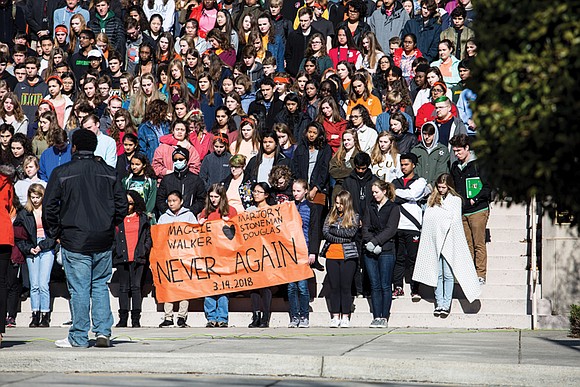Walkout
City students join Wednesday’s national demonstration for tougher gun laws on one-month anniversary of Florida high school massacre
3/16/2018, 6:59 a.m.

By Ronald E. Carrington
Hundreds of Richmond area students joined their peers across the country and walked out of classrooms at 10 a.m. Wednesday to demand stricter gun laws in a national show of unity and solidarity one month after the bloody massacre that killed 17 students and staff at a Florida high school.
Roughly half of the 751 students at the Maggie L. Walker Governor’s School for Government and International Studies marched out and stood on the front steps of the Lombardy Street school.
Like many of the demonstrations across the country, the students’ walkout lasted 17 minutes to honor of the 17 lives lost when Nikolas Cruz, a former student at Marjory Stoneman Douglas High School in Parkland, Fla., opened fire on Feb. 14. He was armed with an AK-15 military-style assault rifle.
Seventeen Maggie Walker students each read a 20-second tribute to one of the dead in Florida. Several in the crowd, wrapped in coats and blankets in the morning chill, held a sign stating, “Never Again.”
The tributes were followed by a moment of silent prayer. The emotional tribute brought some students to tears.
The students gathered behind the bust of Maggie L. Walker, the noted Richmond banker and businesswoman who advanced a myriad of justice and civil rights issues in the early 20th century.
The Richmond students, like those across the country, want Congress to ban assault weapons, require universal background checks before gun sales and pass a law that would allow courts to disarm people who display warning signs of violent behavior.
Co-organizer Catherine Qian, a senior from Chesterfield County, sobbed when she delivered a tribute to 15-year-old Peter Wang, one of the Florida students who was killed in the massacre. He died wearing his JROTC uniform, holding a door to help others escape. He loved JROTC and dreamed of one day entering the U.S. Military Academy at West Point.
“I thought about my brother in the eighth grade who was just accepted to Maggie L. Walker and wants to go to West Point,” Ms. Qian said in an interview after the walkout. “I couldn’t help but see my brother in Peter Wang’s shoes and the fact that this could happen to people just for coming to school and trying to get an education. This is unconscionable to me.”
Students used social media, word of mouth and coordination with the Walker administration and director, Dr. Robert Lowerre, to organize the walkout.
“We have a duty as high school students to remember the victims at Parkland,” said Adam Sachs, a junior from Henrico County, who also helped to organize Wednesday’s event.
“We are here to stand up against the underlying reason for these people being killed and to demand that our legislators fight for gun control. We need to see some legislative action to protect the lives of people and students instead of picking a piece of metal — a gun.”
The demonstrations were prompted by EMPOWER, the youth branch of the Women’s March. Students from snowy Boston to Columbine High School in Colorado, where 13 people students were killed in a 1999 mass shooting, participated in the walkout. Students who survived the Sandy Hook Elementary School attack in December 2012 in which 27 people were killed walked out of Newtown High School in Connecticut.
Fifth-grade students in Akron, Ohio, who were studying the Civil Rights Movement in class, organized a sidewalk protest.
Students hope the nationwide protests will prompt action and change.
But in Virginia, the General Assembly session that closed Wednesday saw all but one of dozens of gun bills killed, including a bill to require universal background checks before gun purchases and a ban on bump stocks, which are used to make semiautomatic weapons fire like an automatic weapon. A bump stock was used in the October mass shooting in Las Vegas in which 59 people were killed and 527 were injured.
However, the messages delivered by young people have had an impact in Florida, where Gov. Rick Scott last week signed the first gun control legislation in 20 years. The law raises the minimum age to buy firearms from 18 to 21, extends a three-day waiting period for handgun purchases to include long guns and bans bump stocks. It also creates a so-called “guardian” program that enables teachers and other school employees to carry handguns.
The National Rifle Association, which is headquartered in Virginia, has filed a federal lawsuit against the state of Florida arguing the new law raising the age for gun purchases violates the Second and 14th Amendments of the U.S. Constitution.
“This bill punishes law-abiding gun owners for the criminal acts of a deranged individual,” said Chris W. Cox, executive director of the NRA Institute for Legislative Action.
On the federal level, the Republican-controlled Congress and President Trump have been ineffective in crafting a gun control bill that addresses the demands of the nation’s protesting high school students.
According to a recent Quinnipiac University poll, 66 percent of Americans want tighter gun control laws. The poll also shows an uptick in support for a ban on assault weapons, with 67 percent favoring such a ban and 29 percent opposing it.







